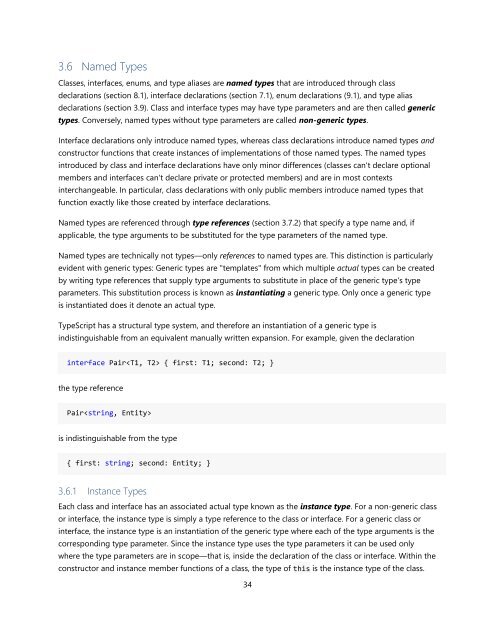TypeScript Language Specification v1.5
TypeScript Language Specification v1.5
TypeScript Language Specification v1.5
You also want an ePaper? Increase the reach of your titles
YUMPU automatically turns print PDFs into web optimized ePapers that Google loves.
3.6 Named Types<br />
Classes, interfaces, enums, and type aliases are named types that are introduced through class<br />
declarations (section 8.1), interface declarations (section 7.1), enum declarations (9.1), and type alias<br />
declarations (section 3.9). Class and interface types may have type parameters and are then called generic<br />
types. Conversely, named types without type parameters are called non-generic types.<br />
Interface declarations only introduce named types, whereas class declarations introduce named types and<br />
constructor functions that create instances of implementations of those named types. The named types<br />
introduced by class and interface declarations have only minor differences (classes can't declare optional<br />
members and interfaces can't declare private or protected members) and are in most contexts<br />
interchangeable. In particular, class declarations with only public members introduce named types that<br />
function exactly like those created by interface declarations.<br />
Named types are referenced through type references (section 3.7.2) that specify a type name and, if<br />
applicable, the type arguments to be substituted for the type parameters of the named type.<br />
Named types are technically not types—only references to named types are. This distinction is particularly<br />
evident with generic types: Generic types are "templates" from which multiple actual types can be created<br />
by writing type references that supply type arguments to substitute in place of the generic type's type<br />
parameters. This substitution process is known as instantiating a generic type. Only once a generic type<br />
is instantiated does it denote an actual type.<br />
<strong>TypeScript</strong> has a structural type system, and therefore an instantiation of a generic type is<br />
indistinguishable from an equivalent manually written expansion. For example, given the declaration<br />
interface Pair { first: T1; second: T2; }<br />
the type reference<br />
Pair<br />
is indistinguishable from the type<br />
{ first: string; second: Entity; }<br />
3.6.1 Instance Types<br />
Each class and interface has an associated actual type known as the instance type. For a non-generic class<br />
or interface, the instance type is simply a type reference to the class or interface. For a generic class or<br />
interface, the instance type is an instantiation of the generic type where each of the type arguments is the<br />
corresponding type parameter. Since the instance type uses the type parameters it can be used only<br />
where the type parameters are in scope—that is, inside the declaration of the class or interface. Within the<br />
constructor and instance member functions of a class, the type of this is the instance type of the class.<br />
34


















